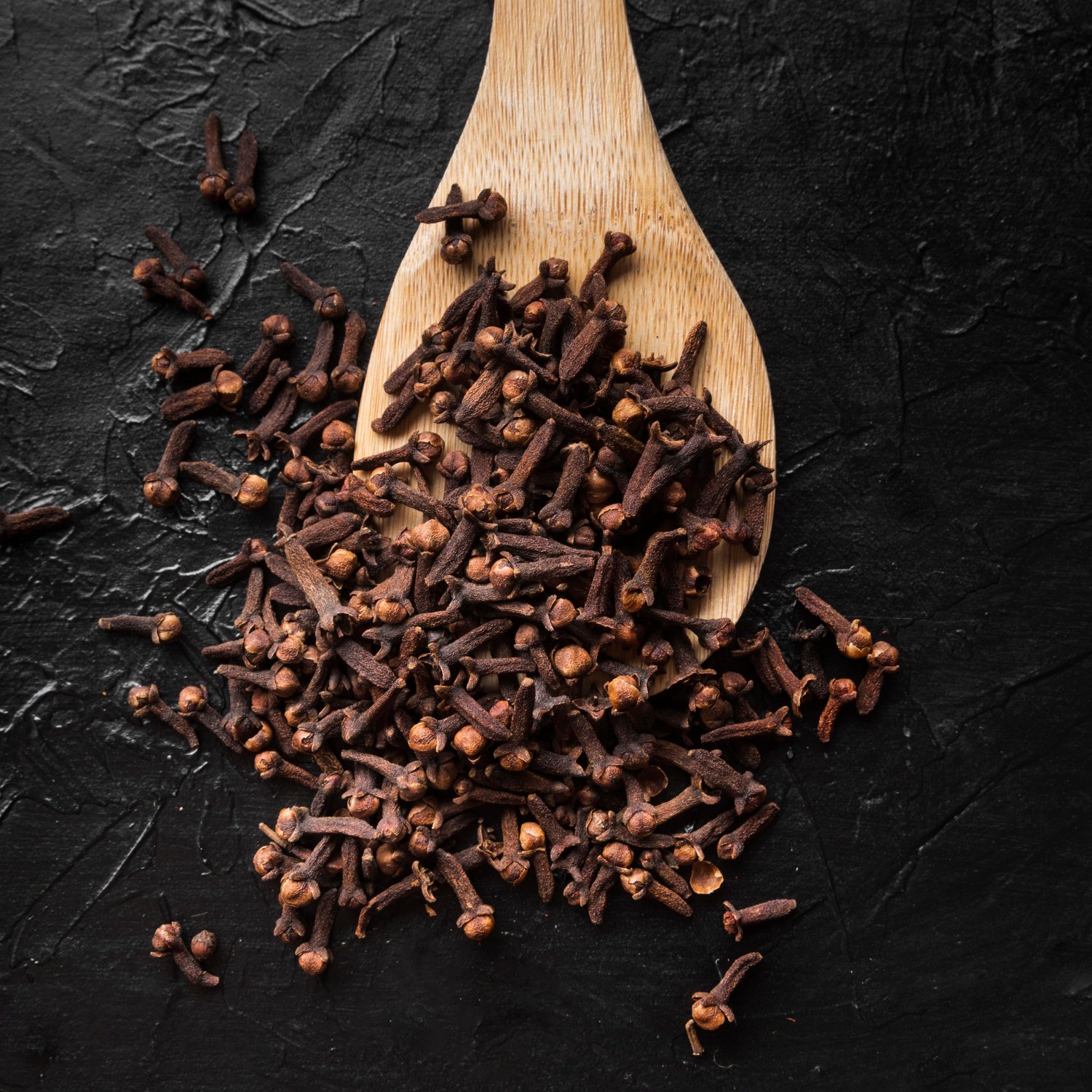Indian Spices
Cloves are primarily the aromatic flower buds of a tree in the family Myrtaceae. The Clove exporter in India exports cloves to around most of the countries in the world. The Clove export from India has been growing over the years due to the popularity of spice all over the world. This is a good business opportunity for the Indian Clove exporter to expand his business and export cloves worldwide. The clove export from India involves exporting various varieties of the spice.
Description
The clove tree is an evergreen that grows up to 8–12 metres (26–39 ft) tall, with large leaves and crimson flowers grouped in terminal clusters. The flower buds initially have a pale hue, gradually turn green, then transition to a bright red when ready for harvest. Cloves are harvested at 1.5–2 centimetres (5⁄8–3⁄4 in) long, and consist of a long calyx that terminates in four spreading sepals, and four unopened petals that form a small central ball.
Clove stalks are slender stems of the inflorescence axis that show opposite decussate branching. Externally, they are brownish, rough, and irregularly wrinkled longitudinally with short fracture and dry, woody texture. Mother cloves (anthophylli) are the ripe fruits of cloves that are ovoid, brown berries, unilocular and one-seeded. Blown cloves are expanded flowers from which both corollae and stamens have been detached. Exhausted cloves have most or all the oil removed by distillation. They yield no oil and are darker in color.


History
Until the colonial era, cloves only grew on a few islands in the Moluccas (historically called the Spice Islands), including Bacan, Makian, Moti, Ternate, and Tidore. One clove tree named Afo that experts believe is the oldest in the world on Ternate may be 350–400 years old.
Cloves were first traded by the Austronesian peoples in the Austronesian maritime trade network (which began at around 1500 BC, later becoming the Maritime Silk Road and part of the Spice Trade). The first notable example of modern clove farming developed on the east coast of Madagascar, and is cultivated in three separate ways, a monoculture, agricultural parklands, and agroforestry systems.
Archaeologist Giorgio Buccellati found cloves in Terqa, Syria, in a burned-down house which was dated to 1720 BC. This was the first evidence of cloves being used in the west before Roman times. The discovery was first reported in 1978. They reached Rome by the first century AD.
Specification
Product Name | Cloves |
Origin | Kanyakumari |
Family | Myrtaceae |
Binomial name | Syzygium aromaticum |
Feature and Characteristic
Color | Dark brown in hue with a reddish tinge. |
Taste and Smell | Subtly sweet flavor that lends plenty of warmth to any dish |
Quality | Oil-rich, whole, unbroken and without stalks, and must not contain any woody, brittle cloves |
Nutritional Information per 100 g (Approx)
Principle | Nutrient Value | Percent of RDA |
Energy | 47 Kcal | 2% |
Carbohydrates | 10.51 g | 8% |
Protein | 3.27 g | 6% |
Total Fat | 0.15 g | 0.50% |
Cholesterol | 0 mg | 0% |
Dietary Fiber | 5.4 g | 14% |
Vitamins
Folates | 68 µg | 17% |
Niacin | 1.046 mg | 6.50% |
Pantothenic acid | 0.338 mg | 7% |
Pyridoxine | 0.116 mg | 9% |
Riboflavin | 0.066 mg | 5% |
Thiamin | 0.072 mg | 6% |
Vitamin A | 13 IU | 0.50% |
Vitamin C | 11.7 mg | 20% |
Vitamin E | 0.19 mg | 1% |
Vitamin K | 14.8 µg | 12% |
Electrolytes
Sodium | 94 mg | 6% |
Potassium | 370 mg | 8% |
Minerals |
|
|
Calcium | 44 mg | 4% |
Copper | 0.231 mg | 27% |
Iron | 1.28 mg | 16% |
Magnesium | 60 mg | 15% |
Manganese | 0.256 mg | 11% |
Phosphorus | 90 mg | 13% |
Selenium | 7.2 µg | 13% |
Phyto-nutrients
Carotene-ß | 8 µg | — |
Crypto-xanthin-ß | 0 µg | — |
Lutein-zeaxanthin | 464 µg | — |

Use and Benifits
Clove USES & BENEFITS :
- Cloves are said to help fight tooth plague. Some research shows that using toothpaste or mouth wash which contains clove is beneficial for your teeth.
- Culinary Cloves may also help reduce excessive sweating. Research states that applying clove oil to the palms for around 2 weeks may help reduce excessive sweating of the palms.
- Culinary Clove oil is also said to be a Mosquito repellent. Applying clove oil or clove oil gel directly to the skin is said to repel mosquitos for up to 5 hours.
- Culinary Applying a solution containing clove oil gel on the skin may also help with severe itching.
- SFB is one of the leading Clove importers from India. We at SFB hold extensive experience in the field of food export and know the ins and outs of the industry. Our global connections and in-depth knowledge of the industry have proved to be useful to many of our past clients. We will help you in the export of clove process right from finding buyers to quality checks and until your products have been successfully delivered to the destination. If you are looking for Clove export from India, Contact SFB now!
